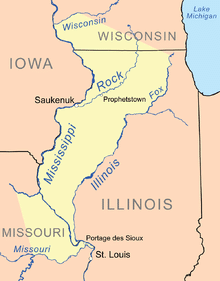The Treaty of St. Louis was signed by Governor William Henry Harrison and representatives of the Sauk and Meskwaki tribes led by Quashquame on November 3, 1804.

In exchange for an annual payment of $1,000 in goods to be delivered to the tribe in St. Louis, the tribes gave up a swath of land stretching from northeast Missouri through almost all of Illinois north of the Illinois River as well as a large section of southern Wisconsin.
The treaty was disliked by the Sauk, especially Chief Black Hawk, who believed that Quashquame did not have the authority to sign such a treaty.
Jump to:
Land Cessations
The land that was given to the United States included the historical villages along the Rock River.
However, the party of Sauk that signed the treaty were not expecting to negotiate land deals and did not bring important tribal leaders who made those decisions. This meant that when the deal was made, and the leaders of the tribes heard about what happened, they instantly disputed it.
Chief Black Hawk never recognized the treaty and said this in his autobiography about the meeting and its intent:
Quashquame, Pashepaho, Ouchequaka, and Hashequarhiqua were sent by the Sacs to St. Louis to try and free a prisoner who had killed an American. The Sac tradition was to see if the Americans would release their friend. They were willing to pay for the person killed, thus covering the blood and satisfying the relations of the murdered man.
Upon return, Quashquame and the party came up and gave us the following account of their mission:
On our arrival in St. Louis, we met our American father and explained to him our business, urging the release of our friend. The American chief told us he wanted to land. We agreed to give him some on the west side of the Mississippi, likewise more on the Illinois side opposite Jeffreon. When the business was all arranged, we expected to have our friend released to come home with us. About the time we were ready to start, our brother was let out of the prison. He started and ran a short distance when he was SHOT DEAD!
This was all they could remember of what had been said and done. It subsequently appeared that they had been drunk the greater part of the time while at St. Louis.
This was all myself and the nation knew of the treaty of 1804. It has since been explained to me. I found by that treaty that all of the country east of the Mississippi and south of Jeffreon was ceded to the United States for one thousand dollars a year. I will leave it to the people of the United States to say whether our nation was properly represented in this treaty. Or whether we received fair compensation for the extent of the country ceded by these four individuals?
To read the full treaty, visit FirstPeople.us
Fallout
The treaty was never recognized by those with influence, and the Native Americans allied themselves with the British during the War of 1812.
The treaty harmed already shaky relations with the natives and provided an argument for an independent Indian state to be a buffer between the United States and Canada.
William Henry Harrison and the Americans acted as if the treaty was legitimate and, thus, disrespecting the traditions of the natives. The men sent to the meeting did not have the authority to make such a decision, but despite that, the Americans viewed it as a legit treaty and enforced it.
Black Hawk argued for years that the treaty was a farce and the land ceded to the Americans should never have been allowed, but it did not matter, and the United States did not treat the natives the same as they would have treated Great Britain or France.
